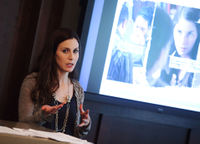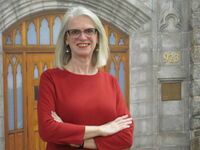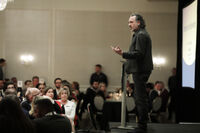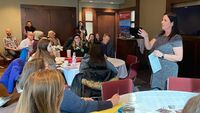By Suzanne Robicheau |
It isn’t easy to take a stand against sexualized violence—even for a self-described “big guy” like Amali Armony, President-Elect of Saint Mary’s University Students’ Association (SMUSA). Thanks to training received through an innovative program called Bringing in the Bystander, Armony and other members of the Saint Mary’s community are now poised to speak up and step in.
“This program has given me new insights,” says Armony. “In the past I might have shied away from intervening in relationship issues, but bystander training will make it possible for me to recognize and safely diffuse incidents before they have a chance to escalate.”
Armony speaks passionately about SMUSA’s readiness to take on a leadership role in maintaining Saint Mary’s commitment to a safe and respectful campus. “Three members of our Executive have been trained as trainers for the Bringing in the Bystander program,” he says, “and the training itself is mandatory for everyone who works for SMUSA, right from the manager of the pub to the staff involved in the Get Home Safe Program.”
Developed by researchers at the University of New Hampshire, Bringing in the Bystander’s curriculum uses a community of responsibility approach to teach bystanders how to speak out against social norms that support sexualized violence such as assault and coercion. “Bystander awareness isn’t something that comes naturally to most people,” says Sarah MacDonald, a Saint Mary’s graduate and Alumni Officer who trained to deliver Bringing in the Bystander to others at Saint Mary’s. “I’m really happy to be involved in this program and to have the opportunity to share what I’ve learned. It’s important to teach people the skills they need to do something positive.”
It’s a sentiment that resonates with the Saint Mary’s community. By March 2015, more than 300 members—students, faculty and staff—had attended bystander training workshops, with additional sessions already planned for spring and summer. Another 30 individuals, including MacDonald and Armony, had volunteered to train to deliver the curriculum across campus.
“We are happy to see these individuals step up as leaders in this initiative,” says Dr. Esther E. Enns, Saint Mary’s University’s Senior Advisor, Teaching and Learning. “Train-the-trainer workshops provide a sustainable way for the University to implement the Bringing in the Bystander curriculum by having our own roster of in-house trainers.”
Enns chairs the President’s Council Action Team, a group charged with implementing recommendations from the Saint Mary’s University President’s Council Report (2013). “The report challenged us to introduce programs to increase the understanding of consent among all members of the university community, and to focus our efforts on peer-to-peer programs,” says Enns. “The message was clear: we all have an important role to play in helping to ensure the safety of everyone on campus.”
According to Enns, bystander training is important on its own as a focal point of the Safe and Respectful Saint Mary’s initiative, but it is also part of a larger picture that includes a Consent Awareness Campaign, online training modules, targeted programming for varsity athletes, the development of an Orientation Steering Committee to oversee the development and execution of orientation, a full-time orientation coordinator to coordinate events and educational initiatives throughout the academic year, and a Declaration of Respect that affirms core values and aligns with existing Saint Mary’s policies and procedures.
“Like other universities, Saint Mary’s faces complex issues,” says Enns. “Because we are built on a tradition of equity and respect, when the need arose to increase feelings of safety on campus, we were able to move quickly. As a result, we have undertaken a large-scale, multi-dimensional initiative to address safety and respect. These are the issues that people worry about, and the programs we have in place to address these issues enhance Saint Mary’s
concern for a just and civil society.”
“The ultimate objective of a Saint Mary’s education is to nurture and support productive, critical, and responsible citizens,” says Enns. “The true value of a university education,” she says, “is realized when it also instills in all members of the University community a strong sense of personal worth, and a commitment to social responsibility.”
In the past year, Saint Mary’s has made significant progress in promoting a safe and respectful environment for students, faculty and staff. “Our work isn’t completed,” says Saint Mary’s President, Dr. J. Colin Dodds, “but we remain committed to the prevention of sexualized violence and to leading the way in addressing a national problem.”
This commitment to leadership prompted Saint Mary’s to host a bystander training session for representatives from the majority of Nova Scotia universities and community colleges. After a full day of training on March 10, 2015, participants returned to their respective institutions prepared to build on skills acquired on our campus.
“We are pleased to collaborate with other educational institutions and to help them build respectful environments for learning and working,” says Dodds. “Creating cultural change is a complex undertaking that requires broad and ongoing commitment. In order to make a difference, we all need to work together.”




